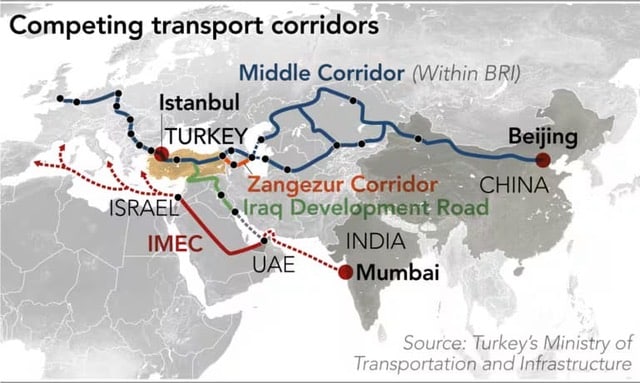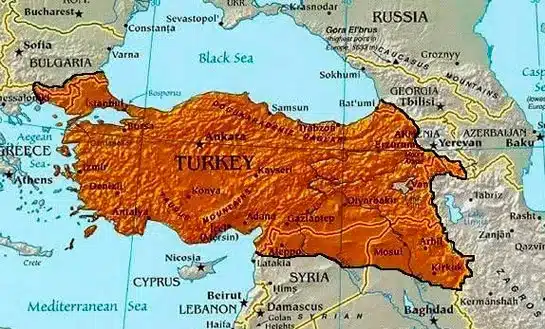Turkey and Iraq's relationship revolves around the most essential resource of all: water. But it also concerns the broader geopolitical advantages of being a nexus point for land-based trade between the East and the West.
Control over water equals power ...
Water is the basis of life. Therefore, control over water resources is the ultimate instrument of power. This was exploited by the earliest civilizations in Mesopotamia. Here, rulers would alternately dam or poison the Tigris River as part of their geopolitics..
Today, there is concern over history repeating itself. The Euphrates and Tigris rivers get their water from rainfall over Anatolia in Turkey. Up to 60% of Syria's freshwater comes from the Euphrates. As much as 98% of Iraq's surface water comes from the Euphrates and Tigris.
This gives Turkey significant geopolitical power, which is likely to increase in the future. For example, Iraq’s population is expected to double by 2055 and triple by 2100.
...which the countries in the region are very aware of
Turkey's challenges include that large parts of the Euphrates and Tigris basins lie in the Anatolian region. The Kurds lay claim to this, see below. This is a major reason for Turkey’s opposition to Kurdish autonomy. Similarly, it is a key reason why Iraq's 2005 constitution granted the Kurdistan region autonomy with its own government, but simultaneously prohibited the formation of an independent state.
Remarkably, no treaties have been signed with either Iraq or Syria that obligate Turkey to maintain a certain water flow in the rivers. Since the 1960s, Turkey has built around 600 dams upstream of both rivers. They plan for a similar number over the next 40 years, despite protests from Syria and Iraq.
This increases the risk of geopolitical conflicts
The risk of conflict is heightened by Turkey's growing geopolitical ambitions. Since 2016, Turkish state media have released maps showing borders along those of the Ottoman Empire (see cover image above). This means a Turkey with borders that extend far into present-day Syria and Iraq, as well as slightly into Iran and Armenia. Meanwhile, President Erdogan has begun to criticize the 1923 Lausanne Treaty, which established Turkey's current borders. This mirrors the strategies used by China and Russia. Putin e.g. referred to historical maps as argument for the invasion of Ukraine in 2022.
Turkey's geopolitical strategy includes establishing itself as the Middle East’s temperate agricultural hub. This would increase Turkey’s water consumption compared to today. But the ambition would also boost its influence over neighboring countries like Azerbaijan, Georgia, Greece, Iraq, Israel, and Syria. Turkey is the "power in the middle."
The country is very aware of this power and seeks to secure it. For example, in the early 1990s, Turkish President Özal responded to anger over the filling of the Atatürk Dam by saying, “We don’t tell the Arab countries what to do with their oil, so we don’t accept any suggestion from them about what to do with our water.”
Iraq has recently attempted to counter this risk offensively through the IDR…
But if Turkey exploits its water power, the risk increases that neighboring countries will unite against it. Turkey’s geopolitical strategy relies on being a global nexus for trade between China/the East and the EU/the West. Therefore, Turkey is interested in reconciling with several of its southern and eastern neighbors.
Many countries have noticed the geopolitical vacuum produced by the western sanctions following Russia's invasion in Ukraine in 2022. Iraq, for instance, has launched a large-scale infrastructure project called the IDR (Iraq Development Road), see the map below.
IDR is one of many recent projects aimed at establishing land-based transport corridors from either China or India to the EU/the West. The project competes directly with the IMEC project. This has slowed significantly since Israel’s war with Hamas. But it also competes directly with Russia’s north-south corridor through Baku and Iran.
...which could simultaneously make Iraq a logistical and geopolitical nexus
The IDR is expected to cost 17 billion USD and span 1,200 km. The key point of the project is the Grand Faw Port in the Persian Gulf. Its capacity is set to rival Port Said in Egypt and Abu Dhabi in the UAE. The project is slated for completion in 2038 and is expected to create 250,000 jobs and generate annual freight revenues of 3-4 billion USD from 25-40 million tons of cargo and 10-13 million passengers per year. The UAE and Qatar signed early agreements to both fund and use the IDR.
This project could shift the region’s power from Tehran towards Baghdad. This would benefit Turkey. Turkey’s interest is further strengthened by the fact that the transport corridor will pass through Kurdish areas in northern Iraq. Therefore, Iraq’s government must reconcile with local rebel groups and the Kurds in a way that doesn’t harm Turkey’s interests.
In April 2024, Erdogan visited Iraq’s president in Baghdad. It was the first state meeting in 13 years, and the parties signed 24 agreements as part of the IDR project. Several of the agreements included guarantees from Turkey regarding water flow in the Euphrates and Tigris rivers. In return, Iraq promised to crack down harder on the Kurdish Workers’ Party (PKK).
Completion of the IDR could strain Turkey's relationship with Egypt, as the IDR is a significant competitor to the Suez Canal. President Erdogan was a strong supporter of Egypt’s former president Mohamed Morsi, who was ousted by the current president, Abdel Fattah al-Sisi, in 2013. Since then, the two countries have often been on opposite geopolitical sides, such as in Libya and regarding natural gas rights in the Eastern Mediterranean.



